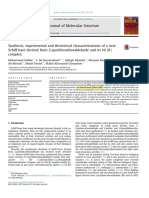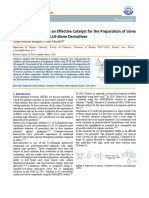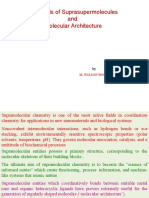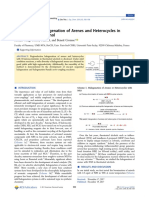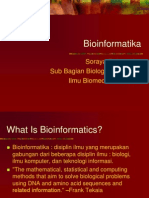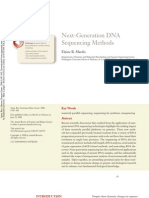33 PDF
33 PDF
Uploaded by
IvenksCopyright:
Available Formats
33 PDF
33 PDF
Uploaded by
IvenksOriginal Title
Copyright
Available Formats
Share this document
Did you find this document useful?
Is this content inappropriate?
Copyright:
Available Formats
33 PDF
33 PDF
Uploaded by
IvenksCopyright:
Available Formats
Vol.2, No.
4 (2009), 972-980
ISSN: 0974-1496
CODEN: RJCABP
http://www.rasayanjournal.com
NAPHTHALENE DERIVATIVES : A NEW RANGE OF
ANTIMICROBIALS WITH HIGH THERAPEUTIC VALUE
Y.B. Rokade and R.Z. Sayyed*
G.R.Y. Institute of pharmacy, Borawa, Khargone, Madhya Pradesh (India)
*
P.G. Department of Microbiology, P.S.G.V.P. Mandals S. I. Patil Arts, G. B. Patel Science &
S.T.S.K.V.S. Commerce College, Shahada, Maharashtra-425409, India
*E-mail: sayyedrz@gmail.com
ABSTRACT
The discovery, development and identification of biologically active compounds has gain lot of importance in the
recent years, even though there is considerable number of adverse effects, the medicinal chemists have always tried
to design drug substance possessing maximum therapeutic application and minimum toxicity. Combinatorial
synthesis has brought lot of evolution in the recent trends of drug synthesis. Naphthalene has been identified as new
range of potent antimicrobials effective against wide range of human pathogens. They occupy a central place among
medicinally important compounds due to their diverse and interesting antibiotic properties with minimum toxicity.
Keywords: Naphthalene, antimicrobial activity.
INTRODUCTION
Naphthalene as antimicrobial agent
Several naphthalene containing drugs are available, such as nafacillin, naftifine, tolnaftate, terbinafine,
etc. which play vital role in the control of microbial infection. Several other synthetic derivatives have
also been reported which possess significant and satisfactory antimicrobial property. -naphthol
commonly used as dye possess a very good antimicrobial property 1
Chemistry of naphthalene:
1. Naphthalenes
Naphthalene is the simplest and the most important member of this class of arenas, in which two benzene
rings are fused in ortho positions.
Fig-1:Naphthalene
Physicochemical properties
Naphthalene is a colorless solid which forms shining flaked-crystal, its melting point is 82.2oC. It has
familiar odor of moth balls. It is very volatile and sublimes slowly at room temperature. Naphthalene is
insoluble in water, moderately soluble in alcohol, highly soluble in ether and benzene. It burns with a
smoky flame.
Naphthalene gives the usual aromatic electrophonic substitution reaction as shown in Fig 2.
H E
+
E
NAPHTHALENE DERIVATIVES Y.B. Rokade and R.Z. Sayyed
Vol.2, No.4 (2009), 972-980
Fig.-2:Aromatic substitution reaction of naphthalene
2.Naphthol
The mono hydroxy derivatives of naphthalene are called naphthol
OH OH
Fig.-3a: 1-napthol Fig.-3b: 2-napthol
Preparation
Both 1 and 2 naphthols are prepared from the corresponding naphthalene sulphonic acids by fusion with
sodium hydroxide at 300oC followed by acidification.
ONa
SO3H OH
H2SO4 NaoH
0 0
40 c 300 c H2O
Fig.-4: Preparation of 1 and 2-napthol from naphthalene sulphonic acid
Physicochemical properties
They are colorless solid compounds having a melting point of 123-124oC, they are insoluble in water,
benzene and highly soluble in alcohol and ether. Naphthol gives all the chemical reactions characteristic
of phenols 2.
Review of research on naphthalene
Mkpenie et al., 3 have tested azo-2 naphthol and 2-napthol against five representative human pathogenic
microorganisms i.e. Staphylococcus aureus, Escherichia coli, bacillus subtilis, pseudomonas aeruginosa
and streptococcus faecalis. Both azo-2 naphthol and 2-napthol were found equally effective against all
the organisms tested.
N
N
OH
Fig.-5: 1-(4-methylphenylazo), 2-naphthol
The 2- naphthol and azo 2-napthol were screened for the presence of antibacterial constituents against
Staphylococcus aureus and Escherichia coli by Faizul et al., 4, they found naphthol ring as a active
principal component. A series of 2-benzylidene amino naphthothiazoles were designed and synthesized
incorporating the lipophillic naphthalene ring to render them more capable of penetrating various bio-
membranes. Schiff bases were synthesized by the reaction of naphtha [1, 2-d] thiazol-2-amine with
various substituted aromatic aldehydes. 2-(2'-Hydroxy) benzylidene aminonaphtho thiazole was
converted to its Co (II), Ni (II) and Cu (II) metal complexes upon treatment with metal salts in ethanol.
All the compounds were evaluated for their antibacterial activities by paper disc diffusion method with
Gram positive Staphylococcus aureus and Staphylococcus epidermidis and Gram negative Escherichia
coli and Pseudomonas aeruginosa. The minimum inhibitory concentrations of all the Schiff bases and
metal complexes were determined by agar streak dilution 4.
Yildiz et al.,5 synthesized 2-hydroxy-1-napthalene with 6,7-dihydro-13H dibenzo [e,n][1,4]doxomin-2,11
diamine of the ligands and screened in vitro for their antimicrobial potential against Staphylococcus
aureus, Klebsiella pneumoniae, Micrococcus luteusla, Proteus vulgaris, Pseudomonas aeruginosa,
NAPHTHALENE DERIVATIVES 973 Y.B. Rokade and R.Z. Sayyed
Vol.2, No.4 (2009), 972-980
Mycobacterium segments, Bacillus cereus, Liseria monocytogenes, Candida albicans,
Kluyeromycesfrugilis, Rhodotorularubra, debrayomyceshanseni, Hanseniaspora guilliermondi 5.
Zeynep et al., 6 studied the antimicrobial activity of certain chemically synthesized compounds. The
compound containing naphthalene moiety 6
R
S
N N
Fig.-6: Benzylidene aminonaphtho thiazole
1
R
Fig.-7: 2-hydroxy-1-napthalene with 6,7-dihydro-13H dibenzo [e,n][1,4]doxomin-2,11 diamine
The compound 2-hydroxy-1-napthalene with 6,7-dihydro-13H dibenzo [e,n] [1,4] doxomin-2,11 diamine
were studied on the Gram-negative bacteria like Escherichia coli (ATCC 25922) and Pseudomonas
aeruginosa (ATCC 27853), the Gram-positive bacteria like S. aureus (ATCC 25923), MRSA (clinical
isolate), Enterococcus faecalis (ATCC 29212) and fungi like Candida krusei (ATTC 6258) and Candida
albicans (ATCC 10231). The compound was found to have potent antibacterial and antifungal activity.
Nagaraja et al., 8 synthesis of naphthofurans derivative coupled with both quinoline and azetidine nucleus.
This compound exhibited significant antimicrobial activities 8.
1
R R
2
N R
3
R
NH
O N
O Cl
O
Fig.- 8: N-[3-Chloro-2-(2-chloroquinolin-3-yl)-4-oxoazetidin-1-yl] naphtho [2, 1-b] furan-2-Carboxamide
Nagaraja et al.,9 synthesized 2-Aryl-2,3-dihydronaphtho[2,1-b]furo[3,2-b]pyridin-4(1H)-ones were
synthesized from2-hydroxy-1-naphthonitrile 2 and characterized on the basis of chemical, analytical and
spectral data. The compounds screened for antibacterial and antifungal activity9 were found effective
against human pathogenic Gram positive and Gram negative bacteria and fungi.
R
H
N
O
O
Fig.-9: 2-Aryl-2,3-dihydronaphtho[2,1-b]furo[3,2-b]pyridin-4(1H)-ones
NAPHTHALENE DERIVATIVES 974 Y.B. Rokade and R.Z. Sayyed
Vol.2, No.4 (2009), 972-980
R=H,Cl,Br,CH3,OCH3,NO2
Sharma et al., 10 prepared some naphthalene derivatives by incorporating azetidinyl and thiazolidinyl
moieties at its a- or b-positions such as a-(3-chloro-2-oxo-4-substituted)aryl-1-azetidinyl) naphthalenes 6
10, a-((substituted)aryl-4-oxo-1,3-thiazolidin-3-yl) naphthalenes1115, b-(3-chloro-2-oxo-4-substituted
aryl-1-azetidinyl) naphthalenes 2125, and b-(substitutedaryl-4-oxo-1,3-thiazolidin-3-yl) naphthalenes
2630. These compounds have also been screened for acute toxicity and anti-inflammatory and analgesic
activities. Compounds which showed better anti-inflammatory and analgesic activities were also
examined for their ulcerogenic liability and underwent a cyclooxygenase assay 10.
Cl
S
O R R O
O R
N N S Cl
N N
O R
Fig.-10: Synthesis of naphthalene derivatives by incorporating azetidinyl and thiazolidinyl moieties
Zeynep et al., 6 prepared several 2-(5,5,8,8-tetramethyl-5,6,7,8 tetrahydronaphtha--len-2-yl)-1H-
benzimidazole-5-carboxamidine analogues and evaluated for their antibacterial and antifungal activities
against S. aureus, Methicillin-resistant S. aureus (MRSA), C. albicans and C. krusei 6.
N
HN
N Cl
HN
Cl
Fig.-11: 2-(5,5,8,8-tetramethyl-5,6,7,8 tetrahydronaphthalen-2-yl)-1H-benzimidazole-5-carboxamidine
Goksu et al., 12 reported that 5-bromo-6methoxynapthalene-2-carboxylic acid and 5,6
dimethoxynapthalene-2-carboxylic acid were having antibacterial activity against some pathogenic
bacteria under in-vitro conditions 12.
O O
OR OR
MeO MeO
OMe Br
Fig.-12:(5,6 dimethoxynapthalene-2-carboxylic acid) (5-bromo-6methoxynapthalene-2-carboxylic acid)
Kyu Ryu et al., prepared 13 a series of 2-arylamino-5-hydroxy-naphthalene-l,4-diones, 3-arylamino-5-
methoxy-naphthalene-l,4-diones, and 2-arylamino-3chloro-5-hydroxy-naphthalene-l,4-diones and tested
for their in-vitro antifungal activity against the Candida and Aspergillus niger 13.
NAPHTHALENE DERIVATIVES 975 Y.B. Rokade and R.Z. Sayyed
Vol.2, No.4 (2009), 972-980
2
1 O R
O R
1 3
2 R R
NH R
3
R NH
. OH O OCH3 O
1
O R
2
NH R
3
Cl R
OH O
Fig.-13: A series of 2-arylamino-5-hydroxy-naphthalene-l,4-diones, 3-arylamino-5-methoxy-naphthalenae-l,4-
diones,and2-arylamino-3chloro-5-hydroxy-naphthalene-l,4-diones. R1, R2, R3=H, F
Huang et al., 14, evaluated the antimicrobial potential of 18 synthetic naphthalene derivatives and tested
for their anti-inflammatory activity. They prepared naphthalene derivative prepared according to the
Mannich reaction 12.
Fig.-14: Synthetic naphthalene derivative
Ahemed et al., 15 substituted several new 1 H-benzo chromene derivatives with 2-napthols and found
them to possess enhanced biological activity against bacterial, fungal and viral pathogens of human 15.
Azarifar et al., 16 the syntheses of twenty-four 3, dinaphthalene -1-yl substituted 2-pyrazolines containing
certain groups as substituents both on the naphthalene and pyrazoline rings. The compounds were tested
in vitro for antimicrobial activity against Escherichia coli, Staphylococcus aureus, Klebsiella
pneumoniae, Proteus mirabillis, Shigella dysentry and Salmonella typhii at a temperature of 37 C
(1C). It was observed that 81% of the total samples tested showed antimicrobial activity against all the
organisms tested 16.
4
R
N N H
2 H 3
R R
1 H
R
Fig.-15: 3, dinaphthalene -1-yl substituted 2-pyrazolines
Gulay et. al., 17 synthesized new 5(1-/2-napthyloxymethyl)-1,3,4-oxadiazole-2 (3H)-thione,2-amino-5-(1-
2-napthyloxymethyl)-1,3,4-oxadiazole, (1-napthyloxy met--hyl) -1,3,4-oxadiazole-2(3H)-1,3,4-
oxadiazole-2(3H)-one derivatives from 1or/2-napthol. The antimicrobial properties of the compound were
investigated against Staphylococcus aureus, Escherichia coli and Pseudomonas aeruginosa, Candida
albicans, C. krusi and C. parapsilosis 17. The derivatives were found effective against wide range of
pathogenic bacteria and fungi.
NAPHTHALENE DERIVATIVES 976 Y.B. Rokade and R.Z. Sayyed
Vol.2, No.4 (2009), 972-980
H
N N
OCH2
O S
Fig.-16: 5(1-/2-napthyloxymethyl)-1, 3, 4-oxadiazole-2(3H)-thione
N N
OCH2 NH2
O
Fig.-17: 2-amino-5(1-/2-napthyloxymethyl)-1, 3,4oxadiazole
H
N N
OCH2
O O
Fig.-18: (1-/2-napthyloxymethyl)-1,3,4- oxadiazole-2(3H)-1,3, 4oxadiazole-2(3H)-one
Palaska et al.,18 synthesized sixteen 1-(2-naphthyloxyacetyl)-4-substituted-3-thiosemicarbazide, 2-(2-
naphthyloxymethyl)-substitutedamino-1,3,4-oxadiazole,2-(2-naphthyloxymethyl)-5-substitutedamino-
1,3,4, thiadiazole and 5-(2-naphthyloxymeth--yl)-4-substituted-1,2,4-triazole-3-thione derivatives. They
reported these derivatives as effective oral anti-inflammatory agents with reduced side-effects18.
O CONHNHCSNHR
Fig.-19: 1-(2-naphthyloxyaceyl)-5-substituted-3-thiosemicarbazide
N N
O NHR
O
Fig.-20: 2-(2-naphthyloxymethyl)-5-substitutedamido-1,3,4-oxadiazole
H
N N
O S
N
R
Fig.-21: 2-(2-naphthyloxymethyl)-5-substitutedamido-1,3,4-thidiazole
N N
O NHR
S
NAPHTHALENE DERIVATIVES 977 Y.B. Rokade and R.Z. Sayyed
Vol.2, No.4 (2009), 972-980
Fig.-22: 5-(2-naphthyloxymethyl)-5-substitutedamido-1,2,4-triazole-3-thiones
R=CH3, C2H5, CH2-CH=CH2, C6H5
Bansal et al., 19 synthesized 1-acetyl-5-substitutedaryl-3-(-aminonaphthyl)-2-pyrazolines and -
(substituted aminoethyl) amido naphthalenes compounds by reaction of b-acetylamino-naphthalene with
different aromatic aldehydes followedby cyclisation with hydrazine hydrate and with different primary or
secondary amines (Mannichs reaction), respectively. The structures of new compounds were confirmed
by 1H-NMR and IR spectral data. Anti-inflammatory and ulcerogenic activities invivo were evaluated
and compared with the standard drugs 19.
N N.CO.CH2
NH R
Fig.-23: 1-acetyl-5-substitutedaryl-3-(-aminonaphthyl)-2-pyrazolines
NH
CO NHR
Fig.-24: -(substituted aminoethyl) amidonaphthalenes
Strom et al., 20 have reviewed the important structural features affecting the antimicrobial activity of 15-
residue derivatives of lactoferricins. His investigations were based on an alanine-scan of a 15 residue
bovine lactoferricin derivative that revealed the absolute necessity of two tryptophan residues for
antimicrobial activity. They prepared a synthetic 15-residue derivative of bovine lactoferricin (LFB).
containing naphthalene derivative and concluded that 2-naphthalene peptide more active than 1-
naphthalene isomers; 2, the naphthalene moiety in 2-Nal is pointing more away from the b-carbon atom
than in 1-Nal, giving 2-Nal a more elongated shape; 2-Nal thereby has a longer side chain than 1-Nal, and
was able to penetrate deeper into the cell membrane of bacteria, thus offering an explanation as to why
the 2-Nal peptides display a higher antimicrobial activity than the 1-Nal peptides 18.
Oliveira et. al. 21 synthesizd 3-Hydrazino-naphthoquinones as analogs of lapachol. Several 1, 4-
naphthoquinone derivatives having a hydrazino side chain were synthesized from 3-diazo-naphthalene-
1,2,4-trione and tested as potential antimicrobial agents. These naphthoquinone derivatives 2-[N-(1-
acetyl-2-oxo-propylidene) -hydrazino] -3-hydroxy [1,4] naphthoquinone, ethyl2-[(3-hydroxy-1,4-dioxo-
1,4-dihydro-naphthalen-2-yl)-hydrazono]-3-oxo-butyrate, t-butyl2-[(3-hydroxy -1,4-dioxo-1,4-dihydro-
naphthalen-2-yl)-hydrazono]-3-oxobutyrate, 3-hydroxy-2-[(di -O-isopropylidene-malonate)-hydrazino]-1,
4 naphtho-quinone, and diethyl 2- [(3-hydroxy -1,4- dioxo-1,4- dihydro naphthalene -2-yl)-hydrazono]-
malonate showed greater antibacterial activity at the level of the preliminary susceptibility testing in disk
21
.
O
OH
O
N 2
NH R
O 1
O R
Fig.-25: Naphthoquinone derivatives
Ambrogi et al., 22 prepared new halogenated 1, 4-naphthoquinones together with other known 1, 4-
naphthoquinones and screened these derivatives for their antibacterial activity by turbidimetric method
and for antifungal activity by diffusion method on agar medium.
NAPHTHALENE DERIVATIVES 978 Y.B. Rokade and R.Z. Sayyed
Vol.2, No.4 (2009), 972-980
O
4 1
R R
3 2
R R
O
Fig.-26: 1, 4-naphthoquinones
Husain et al., 23 showed the hypoglycemic activity of some thiosemicarcarbazides and
naptholoxyaceticacid derivatives 23.
N N
O NH
S
Fig.-27: 2-(arylamino-5-(2-napthyloxymethyl)-1, 3, 4-thidiazoles
N N
O NH
O
Fig.-28:2-arylamino-5-(2-napthyloxymethyl)-1, 3, 4-oxadiazoles
Marketed drugs containing naphthalene and azetidin-2-one1
O COOH
O
N
NH
S
OC 2 H 5
Fig.-29:Naficilin
REFERENCES
1. Wilson and Gisvolds, Textbook of organic medicinal and pharmaceutical chemistry,. Lippincott,
Williams and Wilkins, Philadelphia pp, 255-257 (2004).
2. A. Behal, B. Bahal, A textbook of organic chemistry, S Chadn and Company Ltd., New Delhi, pp
834-835, (2005).
3. V. Mkpenie, G. Ebong, I. B. Obot, B. Abasiekong, E. Journal of chemistry, 5,431-434(2008).
4. A. Faizul, S. Singh, S. Khokhra, P. Om, J Zhejiang Univ , 8, 446-452(2007).
5. Mustafa Yildiz, Askin Kirnz, and Basaran Dulger , J.Serb.Chem.Soc.72 (3), 215-224 (2007).
6. Zeynep Ates, Alag, Mehmet Alpl, Canank Kusal, Arch. Pharm. Chem. Life Sci., 339,74-80
(2006).
7. Z. Alagoa, S.Yildiz, E. Buyukbingo, Chemotherapy, 53,110113(2007).
8. K Nagaraja, G.Prakash, M. Kumaraswamy, V. Vaidya, and K. Mahadevanb, Arkivoc, (xv), 160-
168 (2006).
9. K Nagaraja, G.Prakash, M. Kumaraswamy, V. Vaidya, and K. Mahadevanb, Arkivoc,(xv) ,142-
152 (2006).
10. S. Sharma, T. Singh, R. Mittal, K Saxena, V. Srivastava, A. Kumar, Arch. Pharm. Chem. Life
Sci., 339, 145-152 (2006).
NAPHTHALENE DERIVATIVES 979 Y.B. Rokade and R.Z. Sayyed
Vol.2, No.4 (2009), 972-980
11. Z. Ates-Alag, M. Alp, C. Kus, S. Yildiz, E. Buyukbing,H. Gker, Arch. Pharm. Chem. Life Sci.
339, 7480 (2006).
12. S. Goksu, M. Tansu, H. Ozdemir, H. Secen, Turk j Chem. 29,199-205 (2005).
13. C. Kyu Ryu and M. Chase, Arch Pharm Res, 28, 750-755 ( 2005).
14. M. Huang, S. Nan Wu, J. Wang, C. Lin, S. Lu, L. Liao, and A. Shen, Drug Devpt Res., 60, 261
269 (2003).
15. Ahmed H. Bedair, Hussien A- Emam, Nagwa A. Ei-hady,Farmaco, 56, 965-973 (2001).
16. Davood Aazarifar and Maseud Shebanzadeh, Molecules, 7, (2002) 885-895.
17. S. Gulay, E. Palaska, M. Ekizoglu, M Ozap, Farmaco, 57, 539-542 (2002).
18. E. Palaska, G. Sahin, P. Kelicen, N. Tugba, Farmaco, 57, 101107(2002).
19. E. Bansal, V. Srivastava, A. Kumar, Eur. J. Med. Chem., 36, 8192 (2001).
20. B. Strom, B. Haug, O. Rekdal, L. Skar, W. Stensen, and S. Svendsen, Biochem. Cell Biol, 80, 65
74 (2002).
21. C. Oliveiraa, F. Mirandaa, F. Ferreiraa, C. Freitasb, F. Rabellob, M. Carballidod and C. Correab,
J. Braz. Chem. Soc., 12,339-345 (2001).
22. V. Ambrogi, D. Artini, I. Decarneri, S. Castellino, E. Dradi,W. Logemann, G. Meinardi, M.
Disomma, G. Tosolini, Br. J. Pharmac., 40, 871-880 (1970).
23. M.Husain, A. Kumar and R. Srivastava, Currt Sci, 55, 644-646 (1986).
(Received: 5 December 2009 Accepted: 11 December 2009 RJC-499)
http:// www.rasayanjournal.com
Be a Proud Life Member of RJC
Life Membership for Individuals: Rs.8000/- for Indians and USD 1000 for others.
Life Membership for Institutional: Rs.10000/- for Indians and USD 1500 for others.
BENEFITS OF LIFEMEMBERSHIP:
1. You will receive the journal and all its special issues regularly life long.
2. You will receive all other future publications (Proceedings, Edited Books, Monographs
etc.) published by RJC on 50% discount.
3. If you are a LIFE MEMBER, you need not to pay subscription fee every time for
publication of your paper in RJC.
4. Youll be a Reviewer for RJC manuscripts of your Field Interest and well publish your
name in our journal.
5. You will be exempted from Registration Fee of any National or International future
events (i.e. workshop, seminars, Conferences etc.) organized by RJC.
6. You may be elected as Editorial Member of RJC (Note: Itll depend upon your
publication and scientific achievements).
7. Youll have a very personalized gift from RJC with Complements.
For being a Life Membership, just mail to editor-in-Chief with your detailed Resume.
NAPHTHALENE DERIVATIVES 980 Y.B. Rokade and R.Z. Sayyed
You might also like
- Strain Improvement 52Document63 pagesStrain Improvement 52dnukhet100% (1)
- JW Student RespirationDocument6 pagesJW Student RespirationJody-Ann MearsNo ratings yet
- No. 167, Vol.2, No.4, 9720980, RJC-499Document9 pagesNo. 167, Vol.2, No.4, 9720980, RJC-499Salih OzerNo ratings yet
- Synthesis and in Vitro Antimicrobial Activity of Some New 1-Thiazolyl-2-Pyrazoline DerivativesDocument5 pagesSynthesis and in Vitro Antimicrobial Activity of Some New 1-Thiazolyl-2-Pyrazoline DerivativesAfrizalNo ratings yet
- 2009 Ijcb 48B (6) 877-881 PDFDocument5 pages2009 Ijcb 48B (6) 877-881 PDFABBS FEN REJI T. F.No ratings yet
- Tridentate Hydrazone Metal Complexes Derived From Cephalexinand 2-Hydrazinopyridine Synthesis, Characterization and Antibacterial ActivityDocument7 pagesTridentate Hydrazone Metal Complexes Derived From Cephalexinand 2-Hydrazinopyridine Synthesis, Characterization and Antibacterial ActivityGina DobritescuNo ratings yet
- JURNAL Sintesis Semi KarbazoneDocument5 pagesJURNAL Sintesis Semi Karbazoneluluatul maghfirohNo ratings yet
- Carbazol 2Document9 pagesCarbazol 2JORGE IVAN CASTRO CASTRONo ratings yet
- Catalytic N-Alkylation of Anilines: A. R. Bayguzina and R. I. KhusnutdinovDocument43 pagesCatalytic N-Alkylation of Anilines: A. R. Bayguzina and R. I. Khusnutdinovdola indupriyaNo ratings yet
- Comprehensive Review of Important Analytical Reagents Used in SpectrophotometryDocument29 pagesComprehensive Review of Important Analytical Reagents Used in SpectrophotometryvarishNo ratings yet
- Cyclization Reactions For Synthesis of Benzthiazole - A ReviewDocument9 pagesCyclization Reactions For Synthesis of Benzthiazole - A ReviewAdvanced Research PublicationsNo ratings yet
- Synthesis and The in Uence of Intramolecular H-Bonding in NMR Spectra of Novel Analogs of Dendrodoine: DiaminothiazoloylbenzothiazolesDocument5 pagesSynthesis and The in Uence of Intramolecular H-Bonding in NMR Spectra of Novel Analogs of Dendrodoine: DiaminothiazoloylbenzothiazolesABBS FEN REJI T. F.No ratings yet
- Synthesis of Novel Pyrido 2 1 B BenzothiDocument37 pagesSynthesis of Novel Pyrido 2 1 B Benzothisafaalaa6666No ratings yet
- Synthesis, Experimental and Theoretical Characterizations of A NewDocument7 pagesSynthesis, Experimental and Theoretical Characterizations of A NewWail MadridNo ratings yet
- Synthesis_and_antioxidant_activityDocument5 pagesSynthesis_and_antioxidant_activityaitNo ratings yet
- Antimicrobial ActivityDocument6 pagesAntimicrobial ActivitySiriboju AkhilNo ratings yet
- Metoda Sinteza DANDocument8 pagesMetoda Sinteza DANA Regular PandaNo ratings yet
- Synthesis and Evaluation of Antioxidant Activity of Semicarbazone DerivativesDocument5 pagesSynthesis and Evaluation of Antioxidant Activity of Semicarbazone DerivativesWalid EbaiedNo ratings yet
- IJETR031512Document5 pagesIJETR031512erpublicationNo ratings yet
- Microwave Induced Synthesis of Azo Compound A Solvent Free Path For Some DyesDocument6 pagesMicrowave Induced Synthesis of Azo Compound A Solvent Free Path For Some DyesDr. Parin H kanaiyaNo ratings yet
- Studies On Schiff Base Transition Metal ComplexesDocument10 pagesStudies On Schiff Base Transition Metal ComplexesDebraj Dhar PurkayasthaNo ratings yet
- Paper Number 11Document7 pagesPaper Number 11taoufik akabliNo ratings yet
- Chemistry Notes and ResearchDocument6 pagesChemistry Notes and Researchscarlet.witch.wanda.witchNo ratings yet
- Report 2Document35 pagesReport 2gurumeetNo ratings yet
- Inorganica Chimica Acta: Research PaperDocument7 pagesInorganica Chimica Acta: Research PaperAyesha HaroonNo ratings yet
- BezodiacepinasDocument5 pagesBezodiacepinasRODRIGO DE JESUS RUBIO ROSASNo ratings yet
- DIAZIDODocument10 pagesDIAZIDOAnita KundalNo ratings yet
- D13literature ReviewDocument4 pagesD13literature ReviewAfrah MNo ratings yet
- Synthesis and Spectrophotometric Study of Some New Azo Dyes Derived From MetoclopramideDocument9 pagesSynthesis and Spectrophotometric Study of Some New Azo Dyes Derived From MetoclopramideDarian HerascuNo ratings yet
- Design, Synthesis and Antifungal Activity of Novel Indole Derivatives Linked With The 1,2,3-Triazole Moiety Via The Cuaac Click ReactionDocument4 pagesDesign, Synthesis and Antifungal Activity of Novel Indole Derivatives Linked With The 1,2,3-Triazole Moiety Via The Cuaac Click ReactionWalid Ebid ElgammalNo ratings yet
- 2006 BarnesDocument9 pages2006 BarnesJoewei NgNo ratings yet
- Antimicrobial Activity PaperDocument5 pagesAntimicrobial Activity PaperFatema HussainNo ratings yet
- Idb Pump FinalDocument28 pagesIdb Pump Finalveda_kisaraNo ratings yet
- DR.reddy's paper methylation with trichoromethylacetimidateDocument4 pagesDR.reddy's paper methylation with trichoromethylacetimidatesvnbhattarNo ratings yet
- Synthesis of Novel 1H-1,2,3-Triazol-1-Yl-Nphenylacetamide Derivatives Using Click Chemistry Via (CuAAC) Approach.Document5 pagesSynthesis of Novel 1H-1,2,3-Triazol-1-Yl-Nphenylacetamide Derivatives Using Click Chemistry Via (CuAAC) Approach.International Journal of Innovative Science and Research TechnologyNo ratings yet
- SDF PDFDocument7 pagesSDF PDFdefender paintsNo ratings yet
- One Pot Multicomponent Synthesis of Novel Thiazol 2 Imines Via Microwave Irradiation and Their Antifungal EvaluationDocument14 pagesOne Pot Multicomponent Synthesis of Novel Thiazol 2 Imines Via Microwave Irradiation and Their Antifungal EvaluationMtro. Javier Alfredo Carballo PereaNo ratings yet
- IndianJPharmSci684510-1619524_042955Document5 pagesIndianJPharmSci684510-1619524_042955ijarbn editorNo ratings yet
- Experiment 6 - Colorful Chemistry: Reactive, and SolventDocument12 pagesExperiment 6 - Colorful Chemistry: Reactive, and SolventAjay Sharma ShankyanNo ratings yet
- Synthesis, Determination of The Lipophilicity, Anticancer and Antimicrobial Properties of Some Fused 1,2,4-Triazole DerivativesDocument16 pagesSynthesis, Determination of The Lipophilicity, Anticancer and Antimicrobial Properties of Some Fused 1,2,4-Triazole DerivativesJhafira Rahma AuliaNo ratings yet
- Synthesis, Enantiomeric Resolution and Optical Properties of 8-CyanohexaheliceneDocument4 pagesSynthesis, Enantiomeric Resolution and Optical Properties of 8-CyanohexaheliceneMourad Ben BraiekNo ratings yet
- Synthesis and Antibacterial Evaluation of Benzazoles Tethered Dihydro (1,3) OxazinesDocument7 pagesSynthesis and Antibacterial Evaluation of Benzazoles Tethered Dihydro (1,3) OxazinesWalid Ebid ElgammalNo ratings yet
- JYPharm 2 273Document7 pagesJYPharm 2 273Rahul B SNo ratings yet
- Synthesis and Biological Activities of Some New Pyrimidine Derivatives From ChalconesDocument8 pagesSynthesis and Biological Activities of Some New Pyrimidine Derivatives From ChalconesvenkatNo ratings yet
- CHJV04I02P0104Document6 pagesCHJV04I02P0104chemistryjournalNo ratings yet
- JCPR 2012 4 2 1259 1265Document7 pagesJCPR 2012 4 2 1259 1265JuvansinhJadejaNo ratings yet
- Synthesis and Antibacterial Activity of 35methyl1phenyl1h123triazol4yl6aryl7h124triazolo34b134thiadiazineDocument10 pagesSynthesis and Antibacterial Activity of 35methyl1phenyl1h123triazol4yl6aryl7h124triazolo34b134thiadiazineFinn NelsonNo ratings yet
- Research ArticleDocument8 pagesResearch ArticleaaindraNo ratings yet
- Synthesis of Imidazole Derivatives and Their Biological ActivitiesDocument39 pagesSynthesis of Imidazole Derivatives and Their Biological ActivitiesWalid EbaiedNo ratings yet
- Chitosan Review Paper 5.6.2023Document26 pagesChitosan Review Paper 5.6.2023madhu chemNo ratings yet
- Molecules 02 00017Document14 pagesMolecules 02 00017Félix Álvarez de BroglieNo ratings yet
- Journal Pre-Proofs: Tetrahedron LettersDocument10 pagesJournal Pre-Proofs: Tetrahedron LettersMuhammad Syahrir PratamaNo ratings yet
- AdeyeyeandLiProfile Diclofenac NaDocument23 pagesAdeyeyeandLiProfile Diclofenac Na3chicagoillinoilmbtNo ratings yet
- Supra Super Molecular Architecture DCDocument16 pagesSupra Super Molecular Architecture DCRaja LakshmiNo ratings yet
- Tetrahedron: Pritesh Prasad, William Aalbersberg, Klaus-D. Feussner, Ryan M. Van WagonerDocument3 pagesTetrahedron: Pritesh Prasad, William Aalbersberg, Klaus-D. Feussner, Ryan M. Van WagonerC1Muhammad Iqbal FarozinNo ratings yet
- J. Org. Chem., 2018, 83 (2), PP 930-938 (Halogenation in HFIP)Document9 pagesJ. Org. Chem., 2018, 83 (2), PP 930-938 (Halogenation in HFIP)ludoNo ratings yet
- Novel Bioremediation Approach For Treatment of Naphthalene, Ammonia-NDocument6 pagesNovel Bioremediation Approach For Treatment of Naphthalene, Ammonia-NPatricckkNo ratings yet
- réf 2014 synth et act biol à voirDocument6 pagesréf 2014 synth et act biol à voirmacho AmarNo ratings yet
- Fused-Ring Heterocyclic ChemistryDocument31 pagesFused-Ring Heterocyclic ChemistrySiddarth PalletiNo ratings yet
- Article Chem Med ChemDocument37 pagesArticle Chem Med ChemgejaNo ratings yet
- Auto OxidationDocument8 pagesAuto OxidationSiti AishahNo ratings yet
- Inorganic Reactions and Methods, The Formation of Bonds to N, P, As, Sb, Bi (Part 2)From EverandInorganic Reactions and Methods, The Formation of Bonds to N, P, As, Sb, Bi (Part 2)A. D. NormanNo ratings yet
- HRTDocument4 pagesHRTIvenksNo ratings yet
- Mechanically Agitated VesselDocument11 pagesMechanically Agitated VesselIvenksNo ratings yet
- Stages in The Development of Commercial FormulationsDocument2 pagesStages in The Development of Commercial FormulationsIvenksNo ratings yet
- Blood Pressure: Take Control of YourDocument16 pagesBlood Pressure: Take Control of YourIvenksNo ratings yet
- Drop Weight MethodDocument14 pagesDrop Weight MethodIvenksNo ratings yet
- Haemophilus Influenzae: Type B (Hib)Document6 pagesHaemophilus Influenzae: Type B (Hib)IvenksNo ratings yet
- Muscular SystemDocument11 pagesMuscular SystemIvenksNo ratings yet
- Lucentis Efficacy in DMEDocument12 pagesLucentis Efficacy in DMEIvenksNo ratings yet
- Mahkota Medical Centre MMCDocument3 pagesMahkota Medical Centre MMCIvenksNo ratings yet
- Tadalafil Oral SuspensionDocument3 pagesTadalafil Oral SuspensionIvenksNo ratings yet
- Esterification ReactionDocument3 pagesEsterification ReactionIvenksNo ratings yet
- Hib 2Document2 pagesHib 2IvenksNo ratings yet
- Tablet GranulationDocument31 pagesTablet GranulationIvenksNo ratings yet
- Dosage FormDocument48 pagesDosage FormbenreuNo ratings yet
- Toate Subiectele Sunt Obligatorii. Se Acord Timpul Efectiv de Lucru Este de 3 OreDocument1 pageToate Subiectele Sunt Obligatorii. Se Acord Timpul Efectiv de Lucru Este de 3 OreSimona ButeNo ratings yet
- Mike 3Document68 pagesMike 3Linda YaoNo ratings yet
- Efficacy of Copper Charged Water Against Candida Albicans 2157 7110 1000583Document3 pagesEfficacy of Copper Charged Water Against Candida Albicans 2157 7110 1000583miskah chairaniNo ratings yet
- Bookshelf NBK21101Document451 pagesBookshelf NBK21101Amr Abbas100% (1)
- Basic Local Alignment Search ToolDocument8 pagesBasic Local Alignment Search ToolfacefaceNo ratings yet
- Non-Gmo Compliance Affidavit - Non-Testable Source - PotatoDocument1 pageNon-Gmo Compliance Affidavit - Non-Testable Source - Potatoallan posadasNo ratings yet
- Molecular Tes, NG and Infec, On Preven, OnDocument50 pagesMolecular Tes, NG and Infec, On Preven, OndjdiekNo ratings yet
- Admission Requirements:: Departmental Honors in BiologyDocument6 pagesAdmission Requirements:: Departmental Honors in Biology4nduksNo ratings yet
- STS GmoDocument31 pagesSTS GmoJulie Ann Camacho BabaNo ratings yet
- KK4650Document7 pagesKK4650commgmailNo ratings yet
- Workshop FlyerDocument2 pagesWorkshop FlyerTTaybiNo ratings yet
- Lipofectamine 2000 Reag ProtocolDocument2 pagesLipofectamine 2000 Reag ProtocolBrian GoodwinNo ratings yet
- Ethanol Tolerance in Bacteria PDFDocument2 pagesEthanol Tolerance in Bacteria PDFReneeNo ratings yet
- 105S3 BCT part2 結報Document5 pages105S3 BCT part2 結報林岳儒No ratings yet
- NIBGE Advertisement 2022Document1 pageNIBGE Advertisement 2022Muhammad ismailNo ratings yet
- BioinformaticsDocument48 pagesBioinformaticsWenny Artha MuliaNo ratings yet
- Gene Transfer Technologies in Plants: Roles in Improving CropsDocument9 pagesGene Transfer Technologies in Plants: Roles in Improving CropsAbhinav VermaNo ratings yet
- Import Alert Issued by US FDA To Company's Formulations Manufacturing Units Situated at SEZ Indore (Pithampur) and Piparia (Silvassa) (Company Update)Document1 pageImport Alert Issued by US FDA To Company's Formulations Manufacturing Units Situated at SEZ Indore (Pithampur) and Piparia (Silvassa) (Company Update)Shyam SunderNo ratings yet
- Designing of Drug Delivery System For Biotechnology Products Considering Stability and Monitoring Methods of Improving Stability.Document24 pagesDesigning of Drug Delivery System For Biotechnology Products Considering Stability and Monitoring Methods of Improving Stability.Smaranika RahmanNo ratings yet
- Clean and Pure Steam SystemsDocument82 pagesClean and Pure Steam SystemsYaqoob Ali100% (3)
- MitosisDocument8 pagesMitosisMilongy JavierNo ratings yet
- Wancowicz JohnDocument1 pageWancowicz Johnapi-456455242No ratings yet
- (E12) GM Food-VocabDocument2 pages(E12) GM Food-VocabAlexandru Marius100% (1)
- Chapter 20: Gene Isolation and ManipulationDocument40 pagesChapter 20: Gene Isolation and ManipulationDeepakshee DubeyNo ratings yet
- Biotechnology Unzipped Promises and Realities - Eric S. GraceDocument264 pagesBiotechnology Unzipped Promises and Realities - Eric S. GraceMayank Pathak100% (1)
- Pooled Procurement Mechanism Reference Pricing COVID-19 DiagnosticsDocument5 pagesPooled Procurement Mechanism Reference Pricing COVID-19 DiagnosticsPhuong Nam NguyenVoNo ratings yet
- Dr. B.S. Singh Et Al Fundamentals of Plant BiotechnologyDocument767 pagesDr. B.S. Singh Et Al Fundamentals of Plant Biotechnologymarc100% (5)
- METAGENOMICS: Genomic Analysis of Microbial CommunitiesDocument18 pagesMETAGENOMICS: Genomic Analysis of Microbial Communitiesconlib100% (1)













